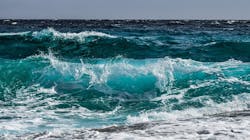Google’s Topaz submarine cable to link Canada and Japan
Via a blog by Bikah Koley, vice president and head of Google global networking and head of technology and strategy, Google has announced Topaz, a submarine cable system that will run between Canada and Japan. The subsea cable will have 16 fiber pairs and a total capacity of 240 Tbps. The company expects Topaz to be ready for service in 2023.
Topaz will land in Vancouver and Port Alberni on Vancouver Island in British Columbia to the east and the prefectures of Mie and Ibaraki in Japan on the west. In addition to Google’s use, the company says it plans to make capacity available to other users. To aid in this process, Topaz will be equipped with wavelength-selective switch (WSS) technology that will enable spectrum slicing. Koley writes that Google also will swap fiber pairs with partners who operate submarine systems along similar routes.
Topaz is the 20th submarine cable in which Google has invested, joining such other undersea systems as Curie, Dunant, Equiano, Firmina and Grace Hopper, and consortium cables like Blue, Echo, Havfrue, and Raman.
For related articles, visit the Network Design Topic Center.
For more information on high-speed transmission systems and suppliers, visit the Lightwave Buyer’s Guide.
To stay abreast of fiber network deployments, subscribe to Lightwave’s Service Providers and Datacom/Data Center newsletters.

Stephen Hardy | Editorial Director and Associate Publisher, Lightwave
Stephen Hardy is editorial director and associate publisher of Lightwave and Broadband Technology Report, part of the Lighting & Technology Group at Endeavor Business Media. Stephen is responsible for establishing and executing editorial strategy across the both brands’ websites, email newsletters, events, and other information products. He has covered the fiber-optics space for more than 20 years, and communications and technology for more than 35 years. During his tenure, Lightwave has received awards from Folio: and the American Society of Business Press Editors (ASBPE) for editorial excellence. Prior to joining Lightwave in 1997, Stephen worked for Telecommunications magazine and the Journal of Electronic Defense.
Stephen has moderated panels at numerous events, including the Optica Executive Forum, ECOC, and SCTE Cable-Tec Expo. He also is program director for the Lightwave Innovation Reviews and the Diamond Technology Reviews.
He has written numerous articles in all aspects of optical communications and fiber-optic networks, including fiber to the home (FTTH), PON, optical components, DWDM, fiber cables, packet optical transport, optical transceivers, lasers, fiber optic testing, and more.
You can connect with Stephen on LinkedIn as well as Twitter.
